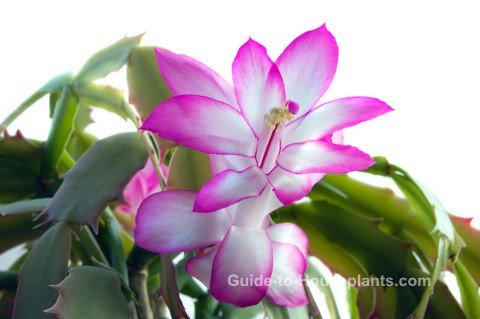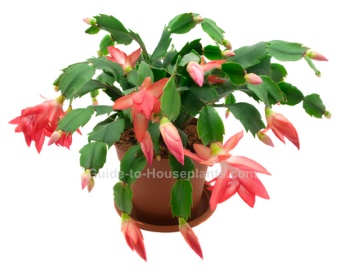





Botanical Name: Schlumbergera truncata
Thanksgiving Cactus is a member of the Cactaceae family. Schlumbergera truncata is the parent of many hybrid Schlumbergeras. In its native habitat, this rain forest cactus is epiphytic, making its home on trees.
Flat stem segments are long and narrow and connected by a mid-rib. Its deeply indented stems look like crab claws, giving it a second common name, Crab Cactus. In late fall, it bears big, beautiful flowers, which may be red, pink, peach, orange, white, or bicolored.

You'll get a fuller plant by pruning. Cutting it back in spring will encourage the plant to branch out where the stem was cut. Flowers emerge from the ends of the stems so you'll get more blooms this way. Spring is the best time to prune it back, when it begins actively growing again.
Pruning tip: Cut the stem off between segments (the place where they're joined together by a midrib). Use sharp, clean pruning shears to prevent tearing the stems.
Put your holiday cactus in front of a bright, cool window while it's in bloom.
How to get the blooms. Flowering results from shorter, cooler days for 8-10 weeks. Putting your cactus outdoors in early fall is ideal. Be sure it's in a shaded location. Bring it back inside before the first frost. Once buds set, don't move the plant around. Flower buds are likely to drop off if the plant is moved or suddenly exposed to temperature changes. If this happens, don't worry. It will bloom beautifully next year.

Origin: Brazil
Height: 12-24 in (30-60 cm)
Light: Bright indirect light
Water: Keep the soil evenly moist, but not soggy while plant is growing. After flowering, water sparingly until new growth begins in spring. Stems will shrivel or wilt if the roots are too dry.
Humidity: Moderate room humidity
Temperature: To set flower buds, the plant needs cool 60-65°F/16-18°C days and 45-55°F/7-13°C nights. Once buds set, 70-75°F/21-24°C days and 60-70°F/16-21°C nights.
Soil: Mix 1 part potting soil and 1 part fine-grade fir bark.
Fertilizer: Feed every 2 weeks with a balanced liquid fertilizer diluted by half. After blooms have dropped, stop fertilizing until new growth begins in spring.
Propagation: Take stem segments in spring. Place upright in moist perlite.
Copyright © www.100flowers.win Botanic Garden All Rights Reserved